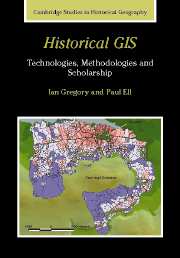Book contents
- Frontmatter
- Contents
- List of figures
- List of tables
- Acknowledgements
- 1 GIS and its role in historical research: an introduction
- 2 GIS: a framework for representing the Earth's surface
- 3 Building historical GIS databases
- 4 Basic approaches to handling data in a historical GIS
- 5 Using GIS to visualise historical data
- 6 Time in historical GIS databases
- 7 Geographic Information Retrieval: historical geographic information on the internet and in digital libraries
- 8 GIS and quantitative spatial analysis
- 9 From techniques to knowledge: historical GIS in practice
- References
- Index
5 - Using GIS to visualise historical data
Published online by Cambridge University Press: 23 June 2009
- Frontmatter
- Contents
- List of figures
- List of tables
- Acknowledgements
- 1 GIS and its role in historical research: an introduction
- 2 GIS: a framework for representing the Earth's surface
- 3 Building historical GIS databases
- 4 Basic approaches to handling data in a historical GIS
- 5 Using GIS to visualise historical data
- 6 Time in historical GIS databases
- 7 Geographic Information Retrieval: historical geographic information on the internet and in digital libraries
- 8 GIS and quantitative spatial analysis
- 9 From techniques to knowledge: historical GIS in practice
- References
- Index
Summary
5.1 INTRODUCTION
While many historians regard GIS as being substantially about mapping, it is hoped that, having reached this stage of this book, it is clear to the reader that GIS is about far more than this: GIS is effectively a spatial database technology concerned with structuring, integrating, visualising and analysing spatially referenced data. The map, and visualisation more generally, is the most readily accessible way of communicating the data held within the GIS and the results from any GIS analysis. It is, however, a huge mistake to equate GIS and mapping as one and the same. If a researcher is simply interested in creating a number of maps as part of a research article, then conventional cartography – probably using a computer – is likely to be the best way to proceed (Knowles, 2000). There are two reasons for this: firstly, the length of time that it takes to create a GIS database, and secondly, GIS tends to lead to rather formulaic maps based around points, lines and polygons, whereas traditional cartography, whether or not it is done on a computer, allows for more freedom of expression.
Nevertheless, GIS and mapping are inseparable.
- Type
- Chapter
- Information
- Historical GISTechnologies, Methodologies, and Scholarship, pp. 89 - 118Publisher: Cambridge University PressPrint publication year: 2007



